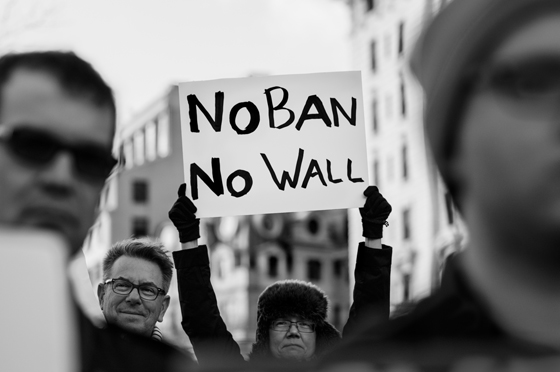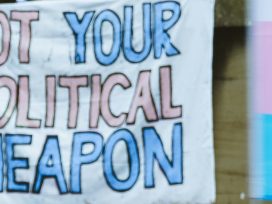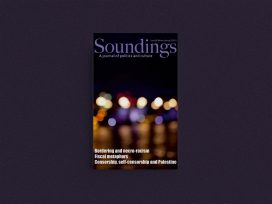The idea that migrants and refugees – particularly those that come from majority Muslim countries – must be subjected to ‘extreme vetting’ has been a staple of Donald Trump’s rhetoric since the beginning of his presidential campaign. This campaign promise served at least two broader purposes: it helped Trump to position himself as a strong law and order candidate, while also turning the latent fear of Islamic terrorism that has defined American politics since 9/11 to his advantage. These moves paid off; he was able to defeat Hillary Clinton in part by arguing that her more open, politically correct, internationalist vision of the world presented a danger to America.
President Trump capped off his first week in office on January 27 by issuing an executive order that barred individuals from seven Muslim countries (Iran, Iraq, Libya, Somalia, Sudan, Syria and Yemen) from entry into the country for 90 days. Although this fell short of his previous call for ‘a total and complete shutdown of Muslims entering the United States,’ the president and his surrogates argued that the order was meant to give his administration time to design and implement a radical screening system to protect America and its citizens from ‘radical Islamic terrorism’.

No Ban No Wall, Thursday evening rally against Trump’s “Muslim Ban” policies sponsored by Freedom Muslim American Women’s Policy. Photo: Lorie Shaull. Source: Flickr
Trump’s campaign promises and executive actions have placed the potential for terrorists to enter to the US by posing as refugees front and center of the contemporary political agenda. However, these concerns are hardly new, nor have they always focused on Islam. Similar debates raged in late 1940s and early 1950s around the displaced persons (DPs) arriving from Europe. At the start of the Cold War, the US was faced with an unprecedented migrant crisis, as refugees fleeing communism poured into DP camps. In most cases, repatriation was not an option. Recognizing the threat that these these so-called ‘escapees’ posed to the political stability of its allies, the government began to resettle many of these individuals in the US.
This wave of postwar migrants was subjected to the first screening procedures for immigrants ever used by the US. This system of ‘extreme vetting’ sought to ensure that communist agents from the eastern bloc did not infiltrate the country. As the US creates new screening procedures to deal with the latest migrant crisis in Europe, an examination of these programs – and their long-term legacies – can provide important insights.
Diaspora and ideological commitment
Looking at the historical record, there is little reason to believe that the vetting systems put in place in the 1940s and 50s prevented the entry of communist subversives. However, the evidence contained in government archives and congressional hearings does show that the United States created a screening process that gave preference to individuals who espoused strong anticommunist views, while blocking many of their more moderate countrymen. Given their strong political convictions, the newly arrived exiles from the Eastern bloc mobilized quickly, creating powerful ethnic lobbies.
Once they had settled in their new homeland, these diaspora communities acted as a powerful constraint on government policy, single-mindedly pushing the US towards a hardline approach towards the communist bloc. Gaining positions in government, the intelligence services and academia an account of their foreign expertise, members of diaspora communities skewed the perceptions of eastern and central Europe in American society. The ideological commitments of these intellectuals and policy-makers resulted in highly propagandized views of the Soviet Union that worked their way into US foreign policy, making peaceful coexistence between the two power blocs more difficult.
This historical precedent is not an argument against screening migrants. However, it should make us conscious of the dangers associated with only allowing migrants with certain political views into the country. There is a real risk that screening procedures designed to keep out radicals will also filter out many migrants with moderate political views. Transposed to the present, the Trump administration must ensure that its zeal in enforcing the ‘extreme vetting’ of Muslims does not lead it to create a system that allows only radical anti-Islamists into the country. This could have detrimental long-term policy consequences for American relations with the Middle East and the Islamic world more generally.
The postwar migrant crisis
At the end of World War II there were already over 7 million eastern and Central European refugees in western Europe. The Allies worked hard to repatriate as many of these individuals as possible, both to lessen the strain on their meager postwar supplies and due to pressure from the countries of the Eastern Bloc, which demanded the return of their citizens. However, their efforts did little to lessen the numbers in the DP camps, as refugee flows to western Europe did not stop with the end of the war. Many individuals from areas ‘liberated’ by the Red Army now sought to avoid new persecution at the hands of the newly installed communist regimes.
By 1952 more than 18,000 people had fled from communist Europe, with more crossing the Iron Curtain every day. Unlike the first wave of migrants who had escaped fascism, this population was broadly anticommunist. Some had played an active role within the Nazi wartime regimes in their homelands as administrators, policemen, officials or even as soldiers. Some were from the wrong social class or had crossed someone within the new communist power structure. Anyone who had not actively resisted the Nazi occupation was in danger.
Although America began accepting individuals from east-central Europe immediately after the war, migration to the United States started in earnest with the admission of this second, anticommunist wave of refugees. The US was happy to accept these immigrants, since many of them possessed important skills. Intellectuals and businessmen had been targeted by the communist regimes due to their bourgeois background. Other migrants were experienced craftsmen and farmhands deemed necessary to maintain the growth of the postwar American economy. The Displaced Persons Act (DPA) of 1948, which ‘authorize[d] for a limited period of time the admission into the United States of certain European displaced persons for permanent residence’, allowed these individuals into the country.
The DPA was also – perhaps even primarily – a response to rising tensions with the USSR at the start of the Cold War. The communist uprising in Hungary in 1947, followed by a coup in Czechoslovak in February 1948 and the Berlin Blockade in June of that same year, had convinced American policymakers that the US had to take a harder line against the Soviet Union. In response, President Truman announced a propaganda campaign that sought to win hearts and minds around the world. Exiles with firsthand knowledge of the situation behind the Iron Curtain were to be an important part of this offensive, as their later activities on Radio Free Europe and other similar platforms would make clear. This ideological battle was so important that the United States was unwilling to deport anyone for fear of the negative publicity this would generate in the communist bloc.
Screening communists out (and anticommunists in)
Although the US saw clear economic and political advantages to admitting desirable migrants, there was also great concern about the possibility of communist subversives infiltrating the US. In order to combat this threat, Congress authorized the executive branch to set up a system to screen all individuals eligible for immigration to America. The vetting process required immigration officials to ensure that no visas were granted to any individual ‘who is or has been a member of, or participated in, any movement which is or has been hostile to the United States or the form of government of the United States’ (DPA, sec. 13).
A number of different agencies participated in carrying out the required investigation. First, the International Refugee Organization carried out a background check of the individuals before they were even considered for eligibility. Next, the information sheet was turned over to the FBI, which made a check against their records. This was followed by a month-long screening by the Counter Intelligence Corps of the US Army and the Immigration and Naturalization Service. This background check included an interview with three neighbors; the acquisition a good-conduct certificate from the local police, the camp officer or another authority to establish that the individual had not been convicted of any crimes; a fingerprint check of local records; and multiple rounds of interrogation. The State Department also conducted a full inquiry before handing over the case to a case analyst at the DP Commission. By the end of the process, the case analysts had an extensive file on every potential migrant.
Throughout the numerous authentication interviews, the burden of proof was always on the migrants to establish their ‘political desirability’. The applicants had to establish that that neither they nor anyone in their family had ever been a member of any party or organization hostile to the United States. They were required to account for each month of their life, corroborated by character statements. The screening was so thorough and time-consuming that the camps filled less than two thirds of their allotted visas, since migrants were not being screened quickly enough.
The undoubtedly successful in blocking the entry of subversives, the system also affected the general composition of the migrant community after World War II. The changing geopolitical situation meant that Nazi affiliations were often overlooked if the individual had other redeeming characteristics, such as scientific knowledge or skills of value to the US intelligence services. Although it is unclear exactly how many Nazis were admitted as a result of these programs, the Director of the Office of Special Investigation put the figure at around 10,000.
The policy legacies of vetting
The anticommunist migrants from east-central Europe mobilized soon after their arrival and quickly began to lobby the US government on behalf of what they perceived to be the interests of their homelands. Exiles from communist Europe were able to take advantage of the openness of US institutions (particularly Congress) to lobbying and the presence of influential allies within the government and the national security establishment who shared their views about communism and the Soviet Union. While it is impossible to quantify the impact of the anticommunist diaspora, the historical evidence suggests that it was quite effective. Moreover, throughout much of the postwar period, America’s propaganda battle against communism reinforced the hardline anticommunist views of many migrants. This encouraged the activities of eastern and central European lobbies in the United States, many of whom raised funds to promote regime change.
Most of the time, the government welcomed this ideological support. However, whenever the US sought to improve relations with the East, ethno-nationalist agitation stalled the process. Throughout the Cold War, proponents of better relations with the Soviet Union often lamented the visceral anticommunism of these radical diaspora communities, who rejected anything that fell short of unconditional freedom for their homelands. Most notably, Henry Kissinger lost considerable influence in the Republican Party after Ronald Reagan’s election in 1981 as a result of the backlash from ethnic lobbies, who saw détente as a betrayal of US promises.
Thanks to their access to the global media and the sensitivity of Congress to lobbying, some even went so far as to claim that diaspora communities had become ‘the single most important determinant of policy’ in America. US presidents throughout the Cold War had to reckon with the possible backlash by anti-communist ethnic groups whenever they attempted to improve relations with the USSR. This demonstrates the influence that geopolitically motivated selection mechanisms had in helping migrants mobilize into powerful lobbies. It also shows how the policy legacies of decisions dictated by world politics can backfire when the geopolitical situation changes.
The dangers of extreme vetting today
The events of 11 September 2001 and subsequent attacks by resident individuals such as the Boston Marathon bombings of April 2013 have highlighted the importance of migration for national security. Although the problems of global terrorism that have brought migration into the spotlight of national security today differ from the postwar migration from east-central Europe in many ways, this latter can still help us reflect on contemporary issues and theoretical concerns.
The geopolitical concerns at the start of the Cold War led the United States to adopt immigration selection criteria that favored the admission of hardline anticommunist migrants to America. Had the United States not screened applicants from east central Europe, it would still have received broadly anticommunist migrants and refugees. These bona fide migrants might also have been accompanied by a few communist subversives. What is certain is that this population would have displayed more diversity in its views and its willingness to act upon them through lobbying and other forms of mobilization. While ethic lobbies would still have formed, they probably would have been less radical and not as active politically.
The powerful postwar ethnic lobbies from eastern and central Europe were the unforeseen result of policies designed to further US security. Today, it is undoubtedly in the American interest to implement immigration policies to keep terrorists out of the country. However, the policy legacies of these selection criteria and the political opportunities that the current policy atmosphere offers must also be considered.
Ever since President George W. Bush’s reference to the crusades when he declared the war on terror in 2001, there has been an unfortunate tendency in the US to conflate Islam with a violent ideology propagated by a small minority in the Middle East. This kind of language serves as a recruiting tool for terrorists around the world, who see it as a confirmation of their Manichean understanding of civilization as a battle between east and west. In the long term, the demonization of Islam serves only to fan the flames of hatred and prolong the ongoing cycle of violence.
Insofar as the immigration of Muslims who want to escape violence and live their lives while practicing their faith helps to calm these tensions, their presence in the US is most welcome. However, ‘extreme vetting’ threatens to skew the composition of the migrants allowed into the country, since apostates and others who have rejected Islam are more likely to make it through the screening process.
This fact, combined with the preference Trump has expressed for authorizing visas for Christians and other minorities over Muslims, threatens to create radical, politically-mobilized diaspora communities that will hinder the resolution of the conflicts between the West and the Islamic world.
This would be a shame, especially considering the limited effectiveness ‘extreme vetting’ is likely to have in actually preventing terrorist attacks on US soil. Instead of helping to prevent violence, such an approach could actually prolong the conflict by creating new the ethnic lobbies like those from eastern and central Europe, who argued so strongly against any form of détente during the Cold War. Although some vetting is certainly warranted, we should make sure that it does not produce detrimental policy legacies and create new, unexpected dangers that will only perpetuate a conflict that has already cost far too many lives.







